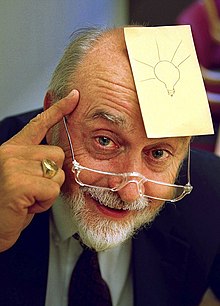Post-it note


A Post-it note is a piece of stationery with a re-adherable strip of adhesive on the back, designed for temporarily attaching notes to documents and to other surfaces: walls, desks, foreheads, computer displays, and so forth. While now available in a wide range of colors, shapes, and sizes, Post-it notes are most commonly a 3-inch (76 mm) square, canary yellow in colour. The notes use a unique low-tack adhesive that enables Post-it notes to be easily attached and removed without leaving marks or residue, unless used on white boards.
It was invented by 3M's Art Fry using an adhesive developed by a colleague, Spencer Silver. Until the 1990s, when the patent expired, Post-it notes were only produced in the 3M plant in Cynthiana, Kentucky. Although other companies now produce them, most of the world's Post-it notes are still made in Cynthiana.
The name "Post-it" and the canary yellow color are trademarks of 3M. Accepted generic terms for competitors include "sticky notes" or "repositionable" or "repositional notes." 3M manufactures other products related to the Post-it note concept, leveraging the success of the brand. Computerized versions of Post-it notes include 3M's own "Post-it Software Notes," and Apple's "Stickies."
History
In 1968, Dr. Spencer Silver, a scientist at 3M in the United States, with the help of Jesse Kops, a fellow scientist, accidentally developed a "low-tack", reusable pressure sensitive adhesive . For five years, Silver promoted his invention within 3M, both informally and through seminars, but without much success. In 1974, a colleague of his, Art Fry, who had attended one of Silver's seminars, came up with the idea of using the adhesive to anchor his bookmark in his hymnbook.[1][2] Fry then developed the idea by taking advantage of 3M's officially sanctioned "permitted bootlegging" policy.[2] 3M launched the product in 1977, but it failed as consumers had not tried the product[3]. A year later 3M issued free samples to residents of Boise, Idaho, United States. 90% of people who tried them said that they would buy the product. By 1980 the product was being sold nationwide in the US;[3] a year later Post-its were launched in Canada and Europe.
In 2003, the company came out with Post-it Super Sticky notes, with a stronger glue that adheres better to vertical and non-smooth surfaces[citation needed].
Standard post-it notes have only partial adhesive coating on the back, along one edge. Similar products are used for specialized purposes with full adhesive coating; the US Post Office uses such yellow address labels to forward mail.
Use in art

In 2004, Paola Antonelli, a curator of architecture and design, included Post-it notes in a show entitled "Humble Masterpieces." Rebecca Murtaugh is a California artist who uses Post-it notes in her artwork. In 2001, she created an installation in her bedroom using $1000 worth of Post-it notes: She covered the whole room in Post-it notes, using the ordinary yellow for objects she saw as having less value, and neon colors for more important objects, such as the bed.[4] Since 2002 Jésica López from Monterrey, Mexico (1979), has been painting series of figures and portraits with acrylic on Post-it notes to depict, for instance, the faces of the Forbes identified "101 most powerful women" of the "Forbes" list of 2006. Some artists create entire murals of colored Post-It notes.
In 2000 the 20th anniversary of Post-it notes was celebrated by having artists create their artwork on Post-it notes. One note that was made by artist R. B. Kitaj sold for £640 in an auction, making it the most valuable Post-it note on record.[5]
In 2003 the Post-it Note was a central role in a new play titled Inside a Bigger Box that premiered in New York at the 78th Street Theatre Lab (written by Trish Harnetiaux and directed by Jude Domsky.) In conjunction with the show Harnetiaux, Domski and the artist non-profit NurtureART curated an International Post-it Note Art exhibit and a panel discussion took place with various artists. Post-it Note inventor Art Fry participated in the panel which was curated by current MOMA head of design Paola Antonelli.
Post-Its are also used by film producers to lay out scenes. They are a very simplistic way of story boarding on a particular project on-the-go. They allow for easy removal of an item from the story board and an easy item to shift around when deciding how to put together many different ideas into one solid shot.
References
- ^ "Inventor of the Week: Art Fry and Spencer Silver". MIT. Retrieved 2007-09-23.
{{cite web}}: Italic or bold markup not allowed in:|publisher=(help) - ^ a b Petroski, Henry (1992). The Evolution of Useful Things. New York: Alfred A. Knopf. pp. 84–86. ISBN 0-679-41226-3. OCLC 24906856.
- ^ a b "A NOTE-able Achievement". 3M. Retrieved 2009-02-01.
{{cite web}}: Italic or bold markup not allowed in:|publisher=(help) - ^ Green, Penelope (2007-07-03). "The all-purpose note that stuck". International Herald Tribune.
{{cite news}}: Check date values in:|date=(help) - ^ "Post-It Note raises £640". BBC News. 2000-12-27. Retrieved 2007-08-23.
{{cite web}}: Italic or bold markup not allowed in:|publisher=(help)
External links
- U.S. patent 3,691,140 -- Acrylate-copolymer microspheres [adhesive formula]
- Post-it homepage
- BBC news article on 20th anniversary of Post-it notes
- 2009 3M Post-it® Notes Game
- The Rake magazine article on 25th anniversary of Post-it notes
- Post-it Note History - The history of the Post-it note according to 3M
